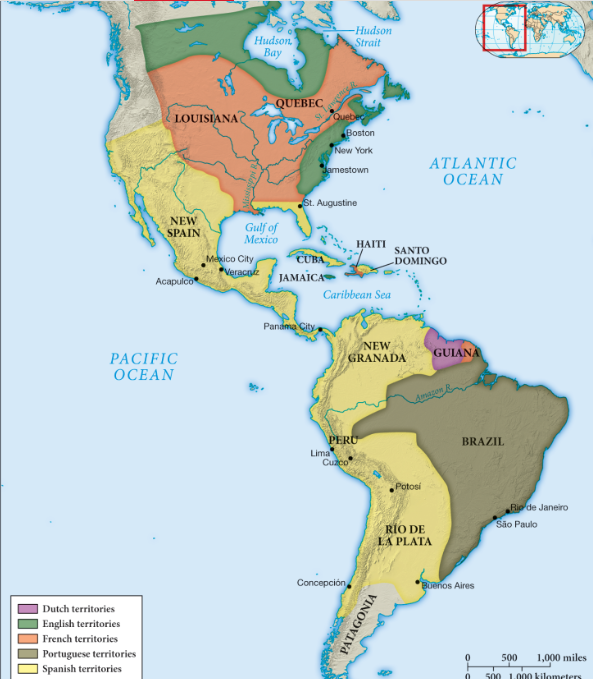Chapter 5 Notes
Landmarks:
| European | 1450 | 1750 |
|---|---|---|
| Spanish Conquest of Aztec and Inca Empires | 1519 | 1540 |
| First Portuguese plantations in Brazil | 1530 ish | |
| Spanish takeover of the Philippines begins | 1565 | |
| Voyages of Columbus to Americas | 1492 | 1502 |
| English colony at Jamestown; French colony in Quebec | 1607 | 1608 |
| Russian Empire | 1450 | 1750 |
| Russia emerges from Mongol rule | 1480 | |
| Russia expansion across Siberia | 1550 | 1795 |
| Russian incorporation of Ukraine | 1648 | 1709 |
| Peter the Great; “westernization” policies | 1689 | 1725 |
| Chinese Empire | 1450 | 1750 |
| Chinese withdraw from the Indian Ocean | 1433 | |
| Qing/Manchu dynasty established | 1644 | |
| Chinese expansion into Central Asia | 1680 | Continue |
| Treaty of Nerchinsk resolves border between Chinese and Russian Empires | 1689 | |
| Ottoman Empire | 1450 | 1750 |
| Ottoman conquest of Constantinople | 1453 | |
| Ottoman conquest of Egypt | 1517 | |
| Siege of Vienna | 1529 | |
| Ottoman military conflict with the Persian Safavid Empire | 1534 | 1639 |
| Mughal Empire | 1450 | 1750 |
| Mughal Empire established | 1526 | |
| Second ottoman siege of Vienna | 1683 | |
| Reign of Akbar | 1556 | 1605 |
| Fragmentation of the Mughal Empire | 1658 | 1707 |
Chapter 5: Political Transformations
Empires and Encounters
1450-1750
The Early Modern Era
European Empires in the Americas
Western Europe was distinctive due to the fact that the conquered territories lay an ocean away from the imperial heart-land rather than adjacent to it
Columbus voyage in 1492
Conquested the Aztec and Inca empires
The European Advantages

Europeans gained highly productive agricultural lands, drove further into expansion, that ultimately underpinned the long-term growth of the European economy into the 19th and 20th centuries
Motives to expand:
An expansion of Europeans was driven through the enduring rivalries of competing European states
Social Class mobility came from the Americas to make a high place in new growing colonies
Missionaries sought to grow Christendom over the Americas
Gave minorities a chance to start a new life
European innovations:
mapmaking
navigation
sailing techniques
Ship design
Gunpowder weapons
horses
Conquistador Hernan Cortes helped in force of the final attack on the Aztecs capital
Europeans brought diseases that had no inclination or experience with the Native American whom were already settled
Rapid build-up of immigration populations
The Great Dying and the Little Ice Age
Europeans and Americans were Chief on the demographic collapse of native Americans
The Great dying was the time of many Spanish and European infiltrative diseases that went to the Americas and killed about 90% of the Native American population
The Little Ice Age was a period from the 13th to 19th century when unusually cold temperatures spanned much of the early modern period in the Northern Hemisphere
General Crisis was the peaks of the Little Ice Age during the cold winters
Growth in the Sahara desert due to cooler weather and rainfall
Europe experienced drought which killed a lot of their food supply
China suffered a drought from 1637 to 1641
The price of maize / corn rose due to droughts
The Columbian Exchange
- In Homework Chart
Comparing Colonial Societies in the Americas
Mercantilism meant that governments served their countries economic interests best by encouraging exports and accumulating bullion
Colonies of Sugar
Europeans found a very profitable substitute in sugar, which was much in demand in Europe, were is was used as a sweetener, a medicine, a spice, a preservative, and in sculptural forms as a decoration that indicated high status
Brazil dominated the world market for sugar
Sugar utilized massive slave labor to make and produce it at a functionable market level (Atlantic slave trade)
Slave worked in terrible conditions from the heat making sugar, the heat from the sun to harvest sugar, and disease
Gender imbalances were applied because men were “stronger”
Although the imbalance they were treated and given the same punishments as the males
Women mostly worked for other women and did domestic chores in house as well as in the fields
Women were separated from their children at auction
Mulattoes - the product of European - African unions
There was an establish defined racial system
Someone in America whom which was Africa was referred to as black but in Brazil they were more specified by where they actually came from and their heritage to form from which racial group they came from
Racism was very high in European colonies against African features
Settler Colonies in North America
The British settelers sought to bring back much of old European society rather than to recreate it
There was a colonial pattern of sharp class hierarchies, large rural estates, and dependent laborers
Men were favored among women in high positions ( Women were inferior to men in every way )
There were far many more British settler compared to Spanish
Diseases and conquering of the Europeans killed of around 85% of the population of Native Americans
Protest England didn’t really feel the need to spread Christianity onto the Native Americans
Europeans used the excuse of reloign for killing the Native Americans
The British government paid little attention to the internal affairs of the colonies